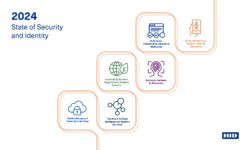11 Airspace Security Trends to Watch Out for in 2021
A Dedrone executive offers projections on the increasing use of drones, and in parallel, the rise in nefarious uses that threaten airspace.

Amit Samani is the vice president of Americas & United Kingdom, sales, at San Francisco-based Dedrone. The company is a leading provider of advanced hardware and software technology used to protect organizations from malicious drones by securing the airspace around facilities and venues. Following are airspace security trends and developments he projects will come to fruition in 2021.
Drone usage will continue to rise exponentially, pushed by the impacts of COVID-19:
- Drones are coming to work in increasing numbers. Facility security leaders are looking to use drones to prevent more workers from coming onsite, putting drones to work for inspection, delivery, surveillance. These numbers of drones coming to work will only increase exponentially and will become a permanent fixture for organizations moving forward.
Increase of disrupted events at airports, stadiums, and other open-air facilities:
- Drone disruptions aren’t new, but more people are realizing how easy it is to cause damage and harm to a facility, and how impactful these drone events are to a business’ reputation. Drones may appear as a part of a broader exploitation plan; check out the site before entering it to identify vulnerabilities. As more open-air facilities remain closed due to COVID-19 shutdowns, and return to normal operations, onlookers will want to take the view into their own hands, such as the drone pilots who shut down Major League Baseball games in 2020.
Drone blackmail will be added as a new security threat:
- Paparazzi chased down celebrities with drones in 2020, and angry neighbors around the world worked with local law enforcement to build frameworks to protect their privacy from drone onlookers. Airspace security protects organizations from drone threats, and an emerging threat in 2021 will be drone-based blackmail. Bad actors are beginning to understand the costs associated with downtime at a critical infrastructure site — airlines who cancelled flights during the Gatwick shutdown reported nearly $64.5 million losses when a wayward drone halted airport operations for two days in 2018.
Significant decrease in the overreliance of DJI / Aeroscope as a platform:
- DJI drones remain the consumer market leader for drone technology and have been joined by legions of drone manufacturers vying to take the No. 1 spot. Combined with market dilution, and increased efforts by the U.S. Government to limit or prohibit Chinese made drones from being used by federal agencies and the military, 2021 will highlight an increase in the diversity of the types of commercial and consumer drones used and effect the technology required to detect drones. Airspace security technology must adapt to detect a variety of drones, and not be limited to a single manufacturer.
Local governments will pioneer drone integration and response infrastructure:
- Cities will begin to think about how to monetize their airspace and integrate drone detection at the local level. In the U.S. the FAA established seven regional UAS testing sites, dedicated to researching and testing UAS operations such as long-range drone delivery, detect and avoid technology, Beyond Visual Line of Sight (BVLOS) operations, counter-drone tech and UAS Traffic Management (UTM), among other drone programs. Especially as cities begin to understand their airspace activity, they will be the pioneers to developing new programs to respond to local drone threats and explore more opportunities to integrate drones as a part of their local infrastructure.
More government counter unmanned aerial systems (cUAS) technology requirements and testing standards will be formalized and executed:
- Central governments have created departments dedicated to the study and integration of drones in their national infrastructure, and in 2021, more governments will take their years of counter-drone market research and formalize their needs and standards for purchasing and integrating counter-drone technology, and how it will be used for national security and anti-terrorism. Leading the charge is the U.K.’s Centre for the Protection of National Infrastructure (CPNI), who was the first central government program that vigorously testing different cUAS platforms to identify leading technologies and accelerate mass procurement and adoption.
Counter-drone technology market consolidation:
- The airspace security market is narrowing down and consolidating between vendors. Counter-drone platforms that have open systems, and integrate multiple technologies, will be open for more opportunities than single-service or single-technology providers.
Drones getting stronger, faster and flying together:
- As drone technology continues to advance, airspace security programs will need to increase not only the scope of types of consumer and commercial drones to detect, but also ensure that drone swarms can be detected as reliably as a single drone. Especially for defense organizations, the smaller threat could be a single drone, but terrorists, criminals and other bad actors will challenge drone detection systems by evading detection either through developing technology difficult to detect, or flying multiple drones in a single instance, such as what was observed at the Palo Verde nuclear power plant, or the “mysterious drone swarm” in Colorado, which prompted months of speculation and investigation, but no answers.
Government programs for remote identification will advance, slowly, but surely:
- Remote Identification programs are being developed in multiple countries, designed to facilitate the collection and storage of certain drone data such as identity, location, and altitude. Aviation authorities understand the need to integrate an identification program for drone users, and have been slow to adopt standards. In 2021, the first remote ID programs will be launched, and more counter-drone technology programs will be sought to integrate into government systems to provide a complete view of both authorized and unauthorized drone activity.
Defeating drone threats will not look the same:
- When it comes to defeating drones, there are certain kinetic solutions which will hard kill the drone, and non-kinetic technologies which will disable or override the drone flight. Defeat systems are still evolving as legislation changes and more organizations become authorized to interdict drones. In 2021, there will be a greater need for more precision electronic warfare attacks that reduce collateral damage. As the drone market changes in 2021, defeat technologies will need to integrate into larger detection systems that can detect a variety of small drones, whether they are commercially available or homebrew. The threat may look different, but when it comes to defeating the drone, security providers will first need to identify, classify, and then deploy a countermeasure.
Advancing homeland security research and legislation:
- As the counter-drone market matures, more researchers and analysts are entering the conversation and providing analysis on the growth and predictions of mass adoption in the next 10-15 years. Laws on cUAS technology are evolving country by country, state by state, city by city. With more researchers, lobbyists and market watchers, 2021 will be the most active year in terms of research and legislation development.
If you enjoyed this article and want to receive more valuable industry content like this, click here to sign up for our FREE digital newsletters!

Security Is Our Business, Too
For professionals who recommend, buy and install all types of electronic security equipment, a free subscription to Commercial Integrator + Security Sales & Integration is like having a consultant on call. You’ll find an ideal balance of technology and business coverage, with installation tips and techniques for products and updates on how to add to your bottom line.
A FREE subscription to the top resource for security and integration industry will prove to be invaluable.







